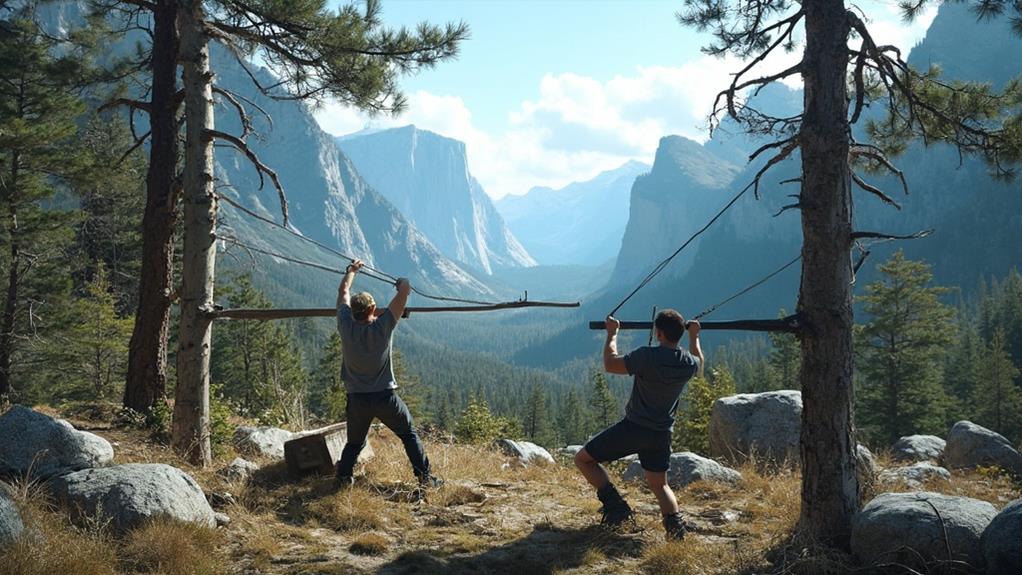Building endurance for multi-day hiking expeditions involves a balanced approach. Start by setting realistic goals that align with your current fitness level, gradually increasing hiking distances by 10-20% each week to avoid injury. Integrate a varied fitness routine including cardiovascular exercises, leg strengthening, and core stability workouts. Simulate hiking conditions with back-to-back hike days, including weighted backpacks to enhance your physical resilience. Equally important is mental preparation through visualization and mindfulness techniques to boost confidence and manage stress. Tracking your progress and connecting with an experienced hiking community can provide valuable insights. Explore further strategies for a successful journey.
Key Takeaways
- Gradually increase hiking distances by 10-20% weekly to build endurance and reduce injury risk.
- Incorporate strength and flexibility exercises like squats and yoga to enhance leg power and balance.
- Engage in cardiovascular activities such as running or cycling for at least 150 minutes weekly.
- Train with weighted backpacks and simulate terrain to prepare for actual hiking conditions.
- Use visualization and mindfulness techniques to boost mental resilience and stress management.
Understanding the Adventure

Setting out on a hiking adventure is more than just setting foot on a trail; it is about cultivating a mindset that embraces the journey's diverse experiences and inherent challenges.
An adventure mindset transcends the notion of merely reaching a destination; it calls for an exploration mindset that fosters personal growth and a deep nature connection. Incremental discoveries made along the way, such as identifying local flora or traversing rocky paths, serve as microcosms of broader life lessons, building confidence and resilience.
Understanding the adventure involves recognizing that each trail presents unique learning experiences. These experiences are not merely about physical endurance but about embracing challenges and finding joy in the journey. This approach fortifies one's resolve, encouraging self-discovery and fostering a sense of accomplishment.
As hikers train for multi-day excursions, mental preparation becomes as essential as physical training, with each step reinforcing one's capabilities and strengths.
Furthermore, the adventure mindset allows for flexibility, acknowledging that training schedules may fluctuate. This resilience development guarantees that one adapts to unexpected situations while maintaining progress towards goals, ultimately leading to a fulfilling and enriching exploration journey.
Setting Realistic Goals

Setting realistic goals is an essential step in building endurance for hiking, as it guarantees that your ambitions align with your current physical capabilities.
Begin by defining achievable milestones, such as gradually increasing your hiking distance by 10-20% each week, and remember to balance your enthusiasm with a practical assessment of your fitness level.
Be prepared to adjust your plans as needed, using feedback from your body and insights from experienced hikers to guide your progress effectively.
Define Achievable Hiking Milestones
Starting on a hiking journey requires thoughtful planning and the establishment of achievable milestones to build endurance without overexertion. Employ hiking motivation techniques and endurance building strategies by setting incremental goals. Begin with manageable distances, gradually increasing them by 10-20% each week. This gradual progression reduces the risk of injury while steadily building stamina. Integrate back-to-back hiking days into your regimen to simulate the endurance needed for multi-day expeditions. Aim for at least two consecutive days of hiking to prepare your body for sustained activity.
To guarantee your training hikes are as effective as possible, mimic the elevation and terrain of your upcoming adventure, progressively increasing difficulty. This approach helps adapt your body to challenging conditions. A balanced training plan incorporating long hikes, strength, and flexibility exercises will develop extensive fitness, vital for tackling demanding trails. Logging distances and times for each hike not only tracks your progress but also serves as a motivational tool, allowing you to visualize improvements and make necessary adjustments.
| Week | Distance Increase | Consecutive Days |
|---|---|---|
| 1 | Base Distance | 1 Day |
| 2 | +10% | 1 Day |
| 3 | +10% | 2 Days |
| 4 | +15% | 2 Days |
| 5 | +20% | 2 Days |
Balance Ambition With Capability
Balancing ambition with capability is vital in setting realistic hiking goals. For multi-day hiking expeditions, it's imperative to conduct a thorough ambition assessment alongside a capability evaluation. This guarantees that your goals are both challenging and achievable, reducing the risk of injury and enhancing overall endurance.
Start by increasing your hiking distance gradually, aiming for a 10-20% increase weekly. This method helps build stamina effectively while allowing your body to adapt to the growing demands.
Incorporating back-to-back hiking days into your training routine is another practical strategy. This simulates real expedition conditions, boosting your physical resilience and preparing you for consecutive days on the trail. Listening to your body is paramount; adjust your training intensity based on how you feel. This keeps your progression sustainable and enjoyable.
Consider the following tips for a balanced approach:
- Structured Flexibility: Design a training plan that accommodates real-life factors, allowing for necessary adjustments while maintaining progress.
- Fitness Monitoring: Use fitness trackers to align your training with your ambitions, enabling accurate assessments of your capabilities.
- Incremental Progress: Gradually increase hiking distances to prevent injury and guarantee effective stamina building.
Adjust Plans as Needed
Recognizing the need to adjust plans is a key component in setting realistic hiking goals. Achieving endurance for multi-day expeditions requires not only physical preparation but also mental adaptability and training flexibility.
Begin by evaluating your current fitness level and incrementally increase your hiking distance by 10-20% weekly. This gradual approach mitigates injury risks and guarantees consistent progress. However, unforeseen factors such as weather adjustments and personal commitments necessitate schedule modifications. Incorporating flexibility into your regimen allows you to adapt to these changes without derailing your overall objectives.
Utilize a training log to document your progress, setbacks, and insights. This tool is invaluable for plan refinement, enabling you to adjust your goals based on real-world experiences.
Accept that setbacks, whether due to injury or fatigue, are part of the journey. Embrace them as learning opportunities, and employ motivation strategies to maintain focus and enthusiasm. Effective injury management and setback recovery are pivotal for sustaining momentum towards your hiking ambitions.
Ultimately, thoughtful adjustments and a resilient mindset will empower you to stay on track, overcoming obstacles and guaranteeing your training aligns with the demands of multi-day hiking expeditions.
Tailoring Fitness Plans

Creating a personalized training strategy is essential for building hiking endurance, allowing you to progressively increase your fitness levels while minimizing the risk of injury.
By integrating fitness routines into your daily lifestyle, such as opting for stairs over elevators or planning active weekends, you can enhance your endurance naturally and sustainably.
Emphasizing a balanced approach that combines varying terrains, strength exercises, and cardiovascular workouts will guarantee you are well-prepared for the diverse challenges of multi-day hikes.
Personalized Training Strategies
Developing a personalized training strategy is essential for enhancing your hiking endurance. Tailoring your fitness plan involves designing customized workouts that progressively build your stamina while minimizing the risk of injury.
Start with manageable distances, increasing them by 10-20% weekly. This gradual progression is critical for effective endurance tracking and sustained development. A balanced approach, combining cardio with strength training, will help condition your body for the demands of multi-day hiking.
Focus on exercises like squats, lunges, and stair workouts to boost leg strength and core stability. To further enhance your cardiovascular endurance, incorporate interval training into your routine. Aim for sessions that maintain your heart rate at 60-80% of its maximum, optimizing your lung capacity and overall endurance.
Logging your training progress is essential. Document distances, elevation gains, and pack weight to visualize achievements and make informed adjustments to your strategy.
- Start with manageable distances: Increase by 10-20% weekly
- Mix cardio and strength training: Focus on legs and core
- Utilize interval training: Target 60-80% max heart rate
Lifestyle Integration Techniques
Integrating fitness into your daily lifestyle is a practical and effective way to enhance hiking endurance. Begin by incorporating urban hiking into your routine—take short, brisk walks during lunch breaks or commute by foot whenever possible, aiming for at least 30 minutes of moderate activity each day. This approach not only boosts cardiovascular endurance but also familiarizes you with the walking conditions similar to those on trails.
Enhance your training by using a weighted backpack during errands; this mimics the demands of carrying a pack while hiking, thereby building functional strength and endurance. Stair climbing, incorporated into your daily activities, can further bolster leg strength and stamina, essential components for tackling diverse terrains during multi-day hiking expeditions.
Additionally, engaging in outdoor activities like day hikes is imperative. Begin with shorter trails of about 5 miles, gradually increasing to 15 miles to develop both endurance and confidence in handling varied landscapes.
Complement these efforts with flexibility and core-strengthening exercises such as yoga or Pilates once a week. These practices improve balance and stability, important for maneuvering challenging trails and reducing the risk of injury.
Building Cardiovascular Strength

Frequently engaging in cardiovascular exercises is vital for building the endurance necessary for hiking. Cardio benefits, such as enhanced heart and lung capacity, are essential for sustaining energy during multi-day expeditions. Incorporating training variations like running, cycling, or swimming for at least 150 minutes per week can greatly bolster your cardiovascular strength.
Additionally, interval training—alternating between high-intensity sprints and moderate-paced recovery—enhances overall stamina and lung capacity by up to 20%. Maintaining a target heart rate of 60-80% of your maximum, calculated as 220 minus your age, guarantees peak workout effectiveness.
To prepare effectively, consider integrating diverse activities into your routine:
- Running and cycling: Enhance cardiovascular endurance and maintain high energy levels over prolonged periods.
- Swimming: Offers a low-impact alternative that strengthens the heart and lungs, important for hiking stamina.
- Hill sprints and stair climbing: Target cardiovascular strength and mimic uphill hiking challenges.
Consistently logging your cardiovascular training progress can help you track improvements and stay motivated.
This structured approach not only refines your endurance but also prepares you for the physical demands of the trail, guaranteeing you are both physically and mentally equipped for your hiking adventures.
Enhancing Leg Muscles

To effectively enhance leg muscles for hiking endurance, incorporating squats and lunges into your training regimen is vital.
These exercises not only target the quadriceps, hamstrings, and glutes, but they also build essential power and stability needed for challenging terrains.
Strengthening Through Squats
When preparing for the rigors of multi-day hikes, strengthening leg muscles through squats is vital to enhancing endurance and performance. Squats target essential muscle groups such as the quadriceps, hamstrings, and glutes, important for traversing challenging terrains.
By incorporating squat variations like jump squats and sumo squats, hikers can boost leg strength and explosive power, which translates into improved hiking capabilities.
Consistent squat training engages the core, promoting better balance and stability on uneven trails, while also contributing to injury prevention. To effectively build strength, a recommended routine involves performing 3-4 sets of 8-12 repetitions, with a gradual increase in weight or intensity over time.
Integrating squats with this workout frequency, ideally 2-3 times a week, fosters significant improvements in endurance and reduces the risk of injury during long hikes.
Consider these key squat variations to maximize your training efforts:
- Jump Squats: Enhance explosive power, aiding in uphill climbs.
- Sumo Squats: Target inner thighs and glutes, important for lateral movements.
- Weighted Squats: Incorporate dumbbells or barbells to increase resistance, boosting overall leg strength.
These targeted exercises are essential for any hiker aiming to excel on multi-day expeditions.
Lunges for Power Building
Lunges are a cornerstone exercise for hikers seeking to build leg power and enhance overall lower body strength. They target essential muscle groups, including the quadriceps, hamstrings, glutes, and calves, which are crucial for tackling challenging terrain on multi-day hiking expeditions.
Walking lunges, in particular, simulate hiking movements, providing a practical way to improve stability and coordination. This exercise naturally involves core engagement, essential for maintaining balance and reducing the risk of injury.
To effectively build power and endurance, aim to perform 2-3 sets of 10-15 lunges per leg, gradually increasing repetitions and intensity as strength improves. This progressive approach guarantees continuous strength development and prepares the body for extended physical exertion.
Incorporating lunge variations such as reverse lunges or lateral lunges can further enhance muscle engagement and prevent workout monotony. These variations challenge the muscles from different angles, contributing to improved balance and flexibility.
Core and Upper Body Training

Building endurance for hiking requires a strategic focus on core and upper body training, essential for enhancing stability and strength during long treks. Developing core stability is fundamental, as it provides the support needed for maneuvering uneven terrain and maintaining balance under the weight of a backpack.
Exercises like planks and side twists with weights should be integral to your routine, with a focus on gradually increasing plank duration to boost endurance.
Simultaneously, upper strength is imperative for carrying heavy backpacks and maintaining posture over consecutive days. Incorporate upper body workouts such as push-ups and pack lifts, aiming for 10-15 repetitions twice a week. These exercises lay the foundation for robust shoulder and arm muscles, which are indispensable during lengthy hikes.
To further enhance your training, consider using resistance bands or free weights targeting the shoulders, back, and arms. This approach guarantees you are well-equipped to manage pack weight effectively.
Additionally, integrating movements that mimic hiking, such as overhead presses with a weighted backpack, simulates real conditions and builds functional strength.
- Core exercises: Planks, side twists with weights
- Upper body workouts: Push-ups, pack lifts
- Resistance training: Bands, free weights targeting shoulders, back, arms
Dedicate at least two sessions weekly to create a balanced routine fostering extensive strength development.
Balance and Flexibility Exercises

Balance and flexibility are often underestimated components of hiking endurance, yet they play an essential role in ensuring a safe and efficient journey. Balance routines, such as standing on one foot for 30-60 seconds, enhance stability, which is important when traversing uneven terrain. This simple exercise reduces the risk of injuries and builds confidence for tackling challenging paths.
Furthermore, incorporating flexibility training into your regimen, like yoga or tai chi, can greatly enhance your ability to navigate landscapes while carrying a pack.
Practicing balance routines while wearing a hiking pack is especially beneficial as it simulates real hiking conditions. This practice trains your body to adapt to different weight distributions and stability challenges, strengthening core muscles necessary for maintaining posture and control.
Additionally, engaging in activities like dynamic lunges or balance board exercises further bolsters your core, ensuring that you remain steady and composed during hikes.
After your hikes or workouts, devote at least five minutes to stretching, holding each stretch for about 30 seconds. This practice maintains flexibility and muscle elasticity, essential for peak hiking performance.
Preventing Injuries

Preventing injuries is paramount for any successful hiking expedition, particularly when preparing for multi-day treks. A thorough injury prevention plan should be an integral part of your preparation strategy. It starts with incorporating stretching techniques that target the hip flexors, quads, and hamstrings, enhancing flexibility and reducing injury risks. Warm up routines and mobility exercises are essential to prepare muscles and joints for the demands of the trail.
Consider the following key strategies:
- Gradual Training Increase: Slowly increase the distance hiked or weight carried to allow your body to adapt, thereby minimizing overuse injuries.
- Strength and Stability: Engage in strength training for legs, core, and back, which supports joint health and fortifies muscles for endurance.
- Hydration and Nutrition: Prioritize hydration and focus on nutrition to fuel your body efficiently and support recovery methods.
Rest strategies are equally important. Listening to your body and adjusting training intensities can prevent fatigue-related injuries.
Recovery methods, such as adequate rest and mental preparation, promote a balanced approach to training. With these practices, you enhance joint health and resilience, paving the way for a successful and injury-free hiking adventure.
Simulating Hike Conditions

To effectively prepare for the challenges of multi-day hikes, it is essential to simulate the conditions you will encounter on the trail. Begin by training in diverse weather conditions, such as rain and wind, to enhance your weather preparation skills. This will help you understand the importance of selecting appropriate hiking gear to stay dry and comfortable.
Incorporate hill or slope training to build the strength and balance necessary for maneuvering elevation changes, vital for maintaining stability and terrain awareness. To mimic the physical demands of the trail, practice hiking with a weighted backpack. Gradually increase the weight to match your anticipated load, ensuring your body adapts to the strain. This approach aids in refining your navigation skills and safety protocols, important when fatigue sets in.
Engaging in consecutive-day hikes will improve your muscle endurance and recovery, preparing you for the sustained effort required during expeditions. Explore local trails with varied terrain to bolster your confidence and familiarity with different surfaces. This will also enhance your understanding of trail etiquette and group dynamics, fostering a harmonious hiking experience.
Additionally, develop hydration strategies and nutrition planning to support your energy levels and be ready for any wildlife encounters.
Mental Resilience Techniques

Mental resilience acts as the backbone of a successful hiking expedition, enabling adventurers to tackle the psychological challenges that accompany multi-day journeys. Developing this strength involves a range of mental strategies designed to enhance endurance and perseverance.
Visualization techniques can be a powerful tool, where hikers picture themselves successfully overcoming trail obstacles and achieving milestones. This can boost both performance and confidence.
Mindfulness practice plays an essential role in stress management during hikes. By focusing on the present moment, hikers can alleviate anxiety, maintain a positive outlook, and manage discomfort effectively.
Positive self-talk is another vital strategy, reinforcing determination and helping hikers push through physical challenges while remaining focused on their overall objectives.
Incorporate these practices to strengthen mental resilience:
- Goal Reflection: Set incremental goals, such as reaching specific landmarks, to stay motivated and celebrate accomplishments.
- Growth Mindset: Reflect on past challenges and the strategies used to overcome them, fostering self-awareness and preparing for future trials.
- Self Awareness: Regularly assess your mental state and adapt strategies to maintain resilience.
These techniques collectively lay the foundation for a successful and fulfilling multi-day hiking experience.
Equipment Familiarization

Familiarizing yourself with your hiking equipment is a critical step in preparing for a successful expedition. Proper gear selection and gear maintenance are paramount to ensuring your comfort and safety during multi-day hikes.
Begin by conducting trial runs in terrain similar to your planned route. This practice helps you get accustomed to the gear, ensuring it functions efficiently in real conditions.
Pay particular attention to packing and carrying your backpack. Experiment with the intended weight distribution to adapt to the load you'll face. This not only builds physical endurance but also helps you understand how your body reacts to carrying weight, allowing you to make necessary adjustments.
Additionally, test your cooking utensils, water systems, and camping gear on shorter hikes to confirm their suitability. Identifying any shortcomings or issues in advance facilitates essential gear maintenance, ensuring everything is in prime condition when it matters most.
Regularly evaluate the items in your backpack to determine what is truly necessary, optimizing weight and packing preferences.
Each hike serves as a valuable learning opportunity, providing insights into how your gear performs. Use these experiences to refine your approach, enhancing your preparedness for the expedition ahead.
Monitoring Progress
With your equipment now thoroughly understood and optimized, the next step in your hiking preparation is to closely monitor your progress. Effective progress tracking and performance analysis are essential to guaranteeing steady improvement in endurance.
Utilizing fitness trackers or apps allows you to log daily hiking distances, elevation gains, and overall workout times—offering a visual representation of your journey. It's important to set specific, measurable goals, such as increasing your weekly hiking mileage by 10-20%. This structured approach guarantees you are consistently challenging yourself without risking injury.
To further enhance your progress tracking, consider maintaining a detailed training journal. Recording your workouts and noting how your body feels during and after each session can help identify patterns and areas needing adjustment.
Regular review against your training plan guarantees alignment with your objectives, allowing for timely modifications.
- Use fitness trackers or apps to log key metrics
- Set incremental goals for continuous improvement
- Maintain a training journal for personal insights
Community and Mentorship

Engaging with a community of fellow hikers can greatly enhance your training experience and success. Participating in group hikes fosters group dynamics and teamwork skills, both essential for maneuvering the challenges of multi-day hiking expeditions. The shared experiences and motivation boost gained from being part of a community can inspire you to push your limits and explore new trails. Community support offers networking opportunities and outdoor connections, facilitating skill exchange and knowledge sharing.
Engagement Method | Benefits
— | —
Group Hikes | Boosts motivation and teamwork skills
Mentorship | Offers insights into gear and training strategies
Online Forums | Provides networking and knowledge sharing
Local Clubs | Facilitates friendship building and community support
Mentorship is another valuable aspect of engaging with a hiking community. Experienced hikers can provide mentorship benefits, sharing insights into essential gear, clothing for various climates, and effective training strategies tailored to individual needs. Interacting with diverse personalities and abilities not only enhances your skill set but also builds confidence in your hiking capabilities. Platforms like local hiking clubs or online forums enable these interactions, creating a supportive network where friendship building is encouraged. By tapping into these resources, you can prepare effectively for your hiking adventures while building lasting outdoor connections.
Practicing Multi-Day Hikes

To effectively prepare for multi-day hikes, it is essential to gradually increase your hiking distances while simulating real expedition conditions.
Incorporating back-to-back hiking days with a weighted backpack will help your body adapt to both the physical demands and recovery needs of consecutive days on the trail.
Carefully monitoring your physical recovery and documenting progress will enable you to fine-tune your training plan, enhancing your endurance and capability to handle varied terrains.
Gradually Increase Distance
Building endurance for hiking requires a strategic approach centered around gradually increasing the distance covered during your training sessions.
Begin by scheduling shorter hikes, and incrementally increase the distance by 10-20% weekly. This method guarantees a solid endurance base without risking injury or burnout. Consistent progress tracking is essential to monitor improvements and adjust distance increments to suit your fitness levels and goals.
To effectively prepare for multi-day hiking expeditions, it's vital to incorporate the following practices:
- Back-to-back hiking days: Simulate the fatigue and stamina demands of a real multi-day hike by scheduling consecutive hiking days. This practice builds resilience and helps your body adapt to continuous exertion.
- Long hikes: Aim for at least one long hike of 15 miles or more each month. These extended treks condition your body for the physical demands of multi-day adventures and build mental toughness.
- Varied terrain: Training on hills and uneven surfaces strengthens muscles and joints, preparing you for the diverse challenges encountered during actual expeditions.
Additionally, using a weighted backpack during practice hikes can enhance the development of strength and endurance, guaranteeing that you are well-prepared for your upcoming hiking adventures.
Simulate Real Hiking Conditions
When preparing for multi-day hiking expeditions, it is vital to simulate real hiking conditions to build both physical endurance and mental resilience. Begin by incorporating back-to-back hiking days into your training regime, progressively increasing both the duration and difficulty. This practice mimics the fatigue encountered on actual expeditions and helps refine your trail route-finding skills.
Carry a loaded backpack weighing between 10-15 kg to acclimate your body to the additional weight you'll bear on your journey.
Choose training trails with varied terrain, including local hills or uneven paths, to develop strength and balance. This will prepare you for the unpredictable nature of wilderness hiking. Aim to schedule practice hikes that mirror your planned expedition regarding length and elevation gain, targeting a maximum elevation change of about 1,000 feet per day. This approach is significant for adjusting to altitude variations.
Practice also involves refining hydration strategies. Train in diverse weather conditions, such as rain or wind, to enhance mental resilience and adaptability.
This preparation guarantees you are ready for unexpected challenges during your trek, ultimately bolstering your confidence and capability in traversing the wild.
Monitor Physical Recovery
One often overlooked aspect of preparing for multi-day hiking expeditions is the essential monitoring of physical recovery. Practicing multi-day hikes allows your body to adapt, enhancing recovery time and endurance. Here's how to effectively manage this critical component:
- Recovery Techniques: Implement active recovery methods, such as stretching and low-intensity activities, to maintain muscle flexibility and prevent stiffness.
- Fatigue Management: Track your recovery patterns using a training log to identify when your body needs rest, enabling effective fatigue management and injury prevention.
- Hydration Strategies and Nutrition Optimization: Guarantee proper hydration and tailored nutrition plans to support recovery and energy replenishment after strenuous hiking days.
Scheduling back-to-back hiking days is pivotal for simulating real expedition conditions. This practice helps in understanding cumulative fatigue impacts and tailoring recovery strategies.
Rest days between hikes are indispensable for muscle recovery and stress reduction, contributing to long-term endurance building. Prioritizing sleep importance and mental recovery aids in rejuvenation, preventing burnout and overtraining.
Incorporating Recovery Strategies

To maximize endurance and performance in hiking, incorporating recovery strategies into your training regimen is essential. Effective recovery techniques are pivotal in preventing overtraining and minimizing injury risks. Schedule at least one full rest day each week, allowing your body time to recuperate.
Implement hydration strategies by maintaining adequate fluid intake; this supports muscle repair and overall recovery. Post-hike activities like light walking, yoga, or stretching for 20-30 minutes can enhance blood flow and aid muscle recovery.
Quality sleep is another cornerstone of effective recovery. Aim for 7-9 hours of sleep per night to facilitate muscle repair and prepare your body for future endurance challenges.
Nutrition plays a critical role; focus on balanced meals rich in carbohydrates, proteins, and healthy fats to replenish energy stores post-hike.
Incorporate foam rolling or massage therapy to alleviate muscle soreness and improve flexibility. These practices help expedite recovery between training sessions, ensuring you remain conditioned for your hiking adventures.
Frequently Asked Questions
How Do You Get Fit for a Multi-Day Hike?
Getting fit for a multi-day hike requires structured cardio exercises and strength training. Prioritize cardiovascular workouts and leg-focused strength exercises like squats and lunges. Incrementally increase intensity and incorporate practical training by simulating conditions with weighted backpacks.
How Do I Increase My Stamina for Hiking?
To increase stamina for hiking, employ interval training to enhance lung capacity and endurance. Integrate diverse hiking techniques, such as varied terrain navigation, to build resilience. This strategic approach fosters gradual improvement, preparing you for more demanding treks.
How to Prepare for a Multi-Day Trek?
To prepare for a multi-day trek, prioritize gear selection and nutrition planning. Choose lightweight, durable equipment and create a balanced meal plan to sustain energy. A well-prepared strategy guarantees a successful, enjoyable trekking experience.
How Long Does It Take to Build Hiking Endurance?
Building hiking endurance typically requires three to six months, contingent on hiking intensity and terrain variation. Gradually increasing distances while incorporating diverse terrains effectively develops stamina, ensuring a practical and encouraging approach to achieving desired endurance levels.
Conclusion
In summary, successfully building endurance for multi-day hiking expeditions requires a thorough approach that includes setting realistic goals, tailoring fitness plans, and focusing on cardiovascular and leg muscle development. Regular monitoring of progress guarantees that adjustments can be made as needed. Engaging with community and mentorship provides valuable insights and support. Practicing multi-day hikes and incorporating effective recovery strategies are essential for preparation. With dedication and perseverance, the ability to tackle challenging hikes with confidence and resilience is attainable.